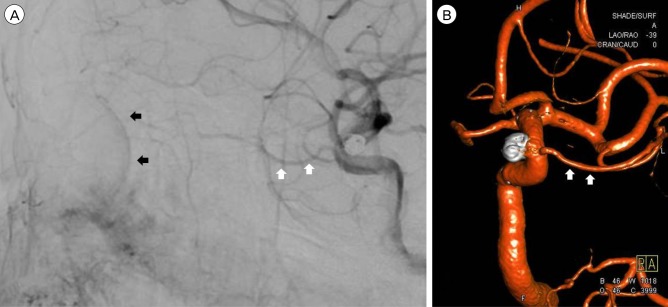J Cerebrovasc Endovasc Neurosurg.
2016 Dec;18(4):369-372. 10.7461/jcen.2016.18.4.369.
Intra-arterial Thrombolysis for Central Retinal Artery Occlusion after the Coil Embolization of Paraclinoid Aneurysm
- Affiliations
-
- 1Department of Neurosurgery, Inje University Haeundae Paik Hospital, Busan, Korea. kusmal@paik.ac.kr
- KMID: 2367328
- DOI: http://doi.org/10.7461/jcen.2016.18.4.369
Abstract
- The most common complication of coil embolization for cerebral aneurysms is thrombo-embolic stroke; in rare cases, these strokes, can present with central retinal artery occlusion. At our institution, a 53-year-old woman underwent stent-assisted coiling of the aneurysm. The patient's vision was improved immediately after intra-arterial thrombolysis and had further improved 8 months later. This report describes our experience of a rare case of central retinal artery occlusion after coil embolization that was successfully treated by intra-arterial thrombolysis.
MeSH Terms
Figure
Reference
-
1. Ascaso FJ, Cristobal JA. Partial retinal artery occlusion after coil embolization of an intracerebral aneurysm. Eur J Ophthalmol. 1999; Apr-Jun. 9(2):142–144. PMID: 10435429.
Article2. Castillo B Jr, De Alba F, Thornton J, DeBrun G, Pulido J. Retinal artery occlusion following coil embolization of carotid-ophthalmic aneurysms. Arch Ophthalmol. 2000; 6. 118(6):851–852. PMID: 10865329.3. Iihara K, Murao K, Sakai N, Shindo A, Sakai H, Higashi T, et al. Unruptured paraclinoid aneurysms: a management strategy. J Neurosurg. 2003; 8. 99(2):241–247.
Article4. Namba K, Higaki A, Nemoto S. Ocular thrombosis after stent-assisted coiling of a c7 (paraclinoid) internal carotid artery aneurysm. A report of two cases and literature review. Interv Neuroradiol. 2014; Jul-Aug. 20(4):455–460. PMID: 25207909.5. Shimizu T, Kiyosawa M, Miura T, Takahashi A, Tamai M. Acute obstruction of the retinal and choroidal circulation as a complication of interventional angiography. Graefes Arch Clin Exp Ophthalmol. 1993; 1. 231(1):43–47. PMID: 8428680.
Article
- Full Text Links
- Actions
-
Cited
- CITED
-
- Close
- Share
- Similar articles
-
- The Effect of Intra-arterial Thrombolysis in Retinal Artery Occlusion: Case Series and Literature Review
- Management of a Complicated Cerebral Aneurysm with Distal Migration of a Detachable Coil: A Case Report
- Intra-arterial Thrombolysis for Central Retinal Artery Occlusion: Two Cases Report
- Intra-arterial and Intravenous Tirofiban Infusion for Thromboembolism during Endovascular Coil Embolization of Cerebral Aneurysm
- Surgical Removal of Coil and Clipping of Aneurysm after Failure of Intraaneurysmal Coil Embolization: Case Report



